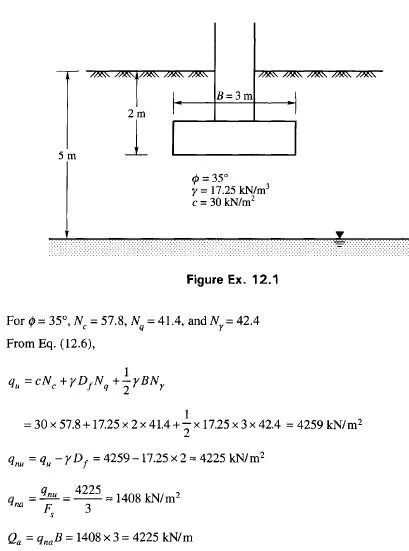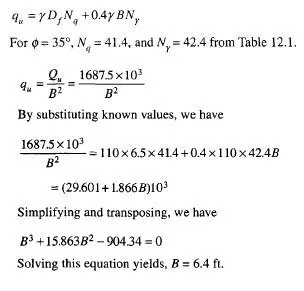According to the method of construction, there are three types of piles. They are
1. Driven piles,
2. Cast-in-situ piles and
3. Driven and cast-in-situ piles.
Driven Piles
Piles may be of timber, steel or concrete. When the piles are of concrete, they are to be precast. They may be driven either vertically or at an angle to the vertical. Piles are driven using a pile hammer. When a pile is driven into granular soil, the soil so displaced, equal to the volume of the driven pile, compacts the soil around the sides since the displaced soil particles enter the soil spaces of the adjacent mass which leads to densification of the mass. The pile that compacts the soil adjacent to it is sometimes called a compaction pile. The compaction of the soil mass around a pile increases its bearing capacity.
If a pile is driven into saturated silty or cohesive soil, the soil around the pile cannot be densified because of its poor drainage qualities. The displaced soil particles cannot enter the void space unless the water in the pores is pushed out. The stresses developed in the soil mass adjacent to the pile due to the driving of the pile have to be borne by the pore water only. This results in the development of pore water pressure and a consequent decrease in the bearing capacity of the soil. The soil adjacent to the piles is remolded and loses to a certain extent its structural strength. The immediate effect of driving a pile in a soil with poor drainage qualities is, therefore, to decrease its bearing strength. However, with the passage of time, the remolded soil regains part of its lost strength due to the reorientation of the disturbed particles (which is termed thixotrophy} and due to consolidation of the mass. The advantages and disadvantages of driven piles are:
Advantages
1. Piles can be precast to the required specifications.
2. Piles of any size, length and shape can be made in advance and used at the site. As a result, the progress of the work will be rapid.
3. A pile driven into granular soil compacts the adjacent soil mass and as a result the bearing capacity of the pile is increased.
4. The work is neat and clean. The supervision of work at the site can be reduced to a minimum. The storage space required is very much less.
5. Driven piles may conveniently be used in places where it is advisable not to drill holes for fear of meeting ground water under pressure.
6. Drivens pile are the most favored for works over water such as piles in wharf structures or jetties.
Disadvantages
1. Precast or prestressed concrete piles must be properly reinforced to withstand handling stresses during transportation and driving.
2. Advance planning is required for handling and driving.
3. Requires heavy equipment for handling and driving.
4. Since the exact length required at the site cannot be determined in advance, the method involves cutting off extra lengths or adding more lengths. This increases the cost of the project.
5. Driven piles are not suitable in soils of poor drainage qualities. If the driving of piles is not properly phased and arranged, there is every possibility of heaving of the soil or the lifting of the driven piles during the driving of a new pile.
6. Where the foundations of adjacent structures are likely to be affected due to the vibrations generated by the driving of piles, driven piles should not be used.
Cast-in-situ Piles
Cast-in-situ piles are concrete piles. These piles are distinguished from drilled piers as small diameter piles. They are constructed by making holes in the ground to the required depth and then filling the hole with concrete. Straight bored piles or piles with one or more bulbs at intervals may be cast at the site. The latter type are called under-reamed piles. Reinforcement may be used as per the requirements. Cast-in-situ piles have advantages as well as disadvantages.
Advantages
1. Piles of any size and length may be constructed at the site.
2. Damage due to driving and handling that is common in precast piles is eliminated in this case.
3. These piles are ideally suited in places where vibrations of any type are required to be avoided to preserve the safety of the adjoining structure.
4. They are suitable in soils of poor drainage qualities since cast-in-situ piles do not significantly disturb the surrounding soil.
Disadvantages
1. Installation of cast-in-situ piles requires careful supervision and quality control of all the materials used in the construction.
2. The method is quite cumbersome. It needs sufficient storage space for all the materials used in the construction.
3. The advantage of increased bearing capacity due to compaction in granular soil that could be obtained by a driven pile is not produced by a cast-in-situ pile.
4. Construction of piles in holes where there is heavy current of ground water flow or artesian pressure is very difficult.
A straight bored pile is shown in Fig. 15.1 (a).
Driven and Cast-in-situ Piles
This type has the advantages and disadvantages of both the driven and the cast-in-situ piles. The procedure of installing a driven and cast-in-situ pile is as follows: A steel shell is driven into the ground with the aid of a mandrel inserted into the shell. The mandrel is withdrawn and concrete is placed in the shell. The shell is made of corrugated and reinforced thin sheet steel (mono-tube piles) or pipes (Armco welded pipes or common seamless pipes). The piles of this type are called a shell type. The shell-less type is formed by withdrawing the shell while the concrete is being placed. In both the types of piles the bottom of the shell is closed with a conical tip which can be separated from the shell. By driving the concrete out of the shell an enlarged bulb may be formed in both the types of piles. Franki piles are of this type. The common types of driven and cast-in-situ piles are given in Fig. 15.1. In some cases the shell will be left in place and the tube is concreted. This type of pile is very much used in piling over water.


